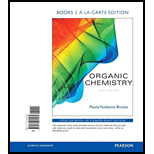
(a)
Interpretation: The Given compounds can be prepared using a Reformatsky reaction has to be described.
Concept introduction: An
On acidic hydrolysis of ester, the
(b)
Interpretation: The Given compounds can be prepared using a Reformatsky reaction has to be described.
Concept introduction: An aldehyde or ketone is reacted with an organozinc reagent. The organozinc reagent is added to the carbonyl of aldehyde. The final product on hydrolysis is required
On acidic hydrolysis of ester, the carboxylic acid can be obtained. To remove a molecule of water, the
(c)
Interpretation: The Given compounds can be prepared using a Reformatsky reaction has to be described.
Concept introduction: An aldehyde or ketone is reacted with an organozinc reagent. The organozinc reagent is added to the carbonyl of aldehyde. The final product on hydrolysis is required
On acidic hydrolysis of ester, the carboxylic acid can be obtained. To remove a molecule of water, the
(d)
Interpretation: The Given compounds can be prepared using a Reformatsky reaction has to be described.
Concept introduction: An aldehyde or ketone is reacted with an organozinc reagent. The organozinc reagent is added to the carbonyl of aldehyde. The final product on hydrolysis is required
On acidic hydrolysis of ester, the carboxylic acid can be obtained. To remove a molecule of water, the
Want to see the full answer?
Check out a sample textbook solution
Chapter 17 Solutions
Organic Chemistry, Books a la Carte Edition (8th Edition)
- What is the product of the reaction? F3C. CF3 OMe NaOH / H₂Oarrow_forwardWhat would you expect to be the major product obtained from the following reaction? Please explain what is happening here. Provide a detailed explanation and a drawing showing how the reaction occurs. The correct answer to this question is V.arrow_forwardPlease answer the question for the reactions, thank youarrow_forward
- What is the product of the following reaction? Please include a detailed explanation of what is happening in this question. Include a drawing showing how the reagent is reacting with the catalyst to produce the correct product. The correct answer is IV.arrow_forwardPlease complete the reactions, thank youarrow_forwardConsider the synthesis. What is compound Y? Please explain what is happening in this question. Provide a detailed explanation and a drawing to show how the compound Y creates the product. The correct answer is D.arrow_forward
- What would be the major product of the following reaction? Please include a detailed explanation of what is happening in this question. Include steps and a drawing to show this reaction proceeds and how the final product is formed. The correct answer is B. I put answer D and I don't really understand what is going on in the question.arrow_forwardWhat is the product of the following reaction? Please explain what is happening in this question. Provide a detailed explanation and a drawing showing how the reagent is reacting with the catalysts to product the correct product. The correct answer is B.arrow_forwardWhat is the missing intermediate 1 and the final product 2. Please include a detailed explanation explaining the steps of malonic ester synthesis. Please include drawings of the intermediate and how it occurs and how the final product is former.arrow_forward
 Organic ChemistryChemistryISBN:9781305580350Author:William H. Brown, Brent L. Iverson, Eric Anslyn, Christopher S. FootePublisher:Cengage Learning
Organic ChemistryChemistryISBN:9781305580350Author:William H. Brown, Brent L. Iverson, Eric Anslyn, Christopher S. FootePublisher:Cengage Learning
 Organic Chemistry: A Guided InquiryChemistryISBN:9780618974122Author:Andrei StraumanisPublisher:Cengage Learning
Organic Chemistry: A Guided InquiryChemistryISBN:9780618974122Author:Andrei StraumanisPublisher:Cengage Learning Introduction to General, Organic and BiochemistryChemistryISBN:9781285869759Author:Frederick A. Bettelheim, William H. Brown, Mary K. Campbell, Shawn O. Farrell, Omar TorresPublisher:Cengage Learning
Introduction to General, Organic and BiochemistryChemistryISBN:9781285869759Author:Frederick A. Bettelheim, William H. Brown, Mary K. Campbell, Shawn O. Farrell, Omar TorresPublisher:Cengage Learning



